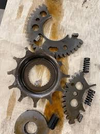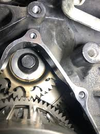ST1100Y
Site Supporter
FYI





Exactly, my 2018 has 108K miles with no problems (Yet).It is a fairly rare occurrence and many Goldwings have no issues even going into the hundreds of thousands of miles. Honda is sending all owners information on this recall by the first week of January.
So less than a .003 chance of having this happen. Honda must be concerned about a potential liability issue if the wheel locks up if this breaks. So far have not heard of this happening only engines suddenly stopping. Just curious where you found this information?As of October 2024 Honda has addressed 51 UBS bolt claims in a pool of 18,196 motorcycles.
It’s in the NHSTA recall.So less than a .003 chance of having this happen. Honda must be concerned about a potential liability issue if the wheel locks up if this breaks. So far have not heard of this happening only engines suddenly stopping. Just curious where you found this information?

Thanks Dave@bdalameda I think this link will open the info.

Home | NHTSA
Get resources and info about staying safe on America’s roads. And, find out if there’s a recall on your car or how to report a vehicle safety problem.www.nhtsa.gov
Based on the defect description it sounds like their concern is increased use increases the risk of failure due to added stress on and fatigue of the bolt.So less than a .003 chance of having this happen. Honda must be concerned about a potential liability issue if the wheel locks up if this breaks.
From what I hear it does not, but there are different rumors.Sounds more random judging by some of the high mileage bikes out there. So the fix does not require pulling the engine?
The engine does not have to be pulled unless the bolt has failed and damaged the engine.Sounds more random judging by some of the high mileage bikes out there. So the fix does not require pulling the engine?
I think those that know if the engine has to be removed or not aren’t talking. Until Honda issues the service bulletin we won’t know exactly what is required.The engine does not have to be pulled unless the bolt has failed and damaged the engine.
I've know of a couple of Wings that have had the UBS bolts replaced without removing the engine, neither had the bolt fail. Here is a link to a discussion about replacing the bolt. on the GL1800 riders forum.I think those that know if the engine has to be removed or not aren’t talking. Until Honda issues the service bulletin we won’t know exactly what is required.
I have read the same thing but Honda issues the service bulletins and it may involve more than a bolt and a gasket. When I went in a dealer to have them run my VIN (this was just days before the NHSTA news) the service writer told me he was on the phone with Honda the day before and was told it's an engine out procedure. We don't have to wait much longer to hear the real deal.I've know of a couple of Wings that have had the UBS bolts replaced without removing the engine, neither had the bolt fail. Here is a link to a discussion about replacing the bolt. on the GL1800 riders forum.
Dan
Unless the D&D bean-counters demand minimum dimension and alloy strength...Seems like in the days of superior CAD designs these things should be bullet proof.
At best CAD is a digital representation of the desired "perfect" part. There are hundreds of steps in the process of that part being manufactured by a supplier all of which can result in deviation from perfect. NO OEM (Honda, Hyundai, BMW) will pay for a perfect part but they set limits on how and how much acceptable parts can deviate from perfect in order to get parts that meet a price point set by the OEM and provide the desired performance. Sometimes the OEM gets the price/performance mix wrong. Sometimes (on a continuum ranging from by honest accident to deviously to improve profits) suppliers sell parts that don't even meet the OEM targets and the OEM installs them on their product. It would be incredibly unlikely for CAD to be the root cause of a recall.This is getting to be the norm now days. Recall with Honda's V6 car engines Hyundai has recalls on their engines, BMW cams and drive shafts, Yamaha with their transmission swaps. Seems like in the days of superior CAD designs these things should be bullet proof.
You Sr have found the sweet spot of communication. Bravo.Finding that sweet spot where the consumers quality and reliability expectations intersect with that consumers ability and willingness to pay to have that expectation fulfilled is the hard part.
